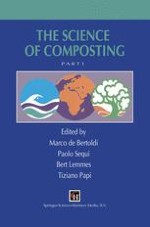1996 | OriginalPaper | Buchkapitel
Minimizing the Cost of Compost Production Through Facility Design and Process Control
verfasst von : Harold M. Keener, David L. Elwell, K. C. Das, Robert C. Hansen
Erschienen in: The Science of Composting
Verlag: Springer Netherlands
Enthalten in: Professional Book Archive
Aktivieren Sie unsere intelligente Suche, um passende Fachinhalte oder Patente zu finden.
Wählen Sie Textabschnitte aus um mit Künstlicher Intelligenz passenden Patente zu finden. powered by
Markieren Sie Textabschnitte, um KI-gestützt weitere passende Inhalte zu finden. powered by
Excessive cost of producing compost at many facilities through out the world continues to burden taxpayers. Observations on failed designs and management strategies in large scale facilities demonstrate operators have not clearly understood the interrelationship of the biological, physical and economic variables on the cost of production. This paper identifies the major variables under management control and their relationship on the cost of producing compost. Governing equations, based on energy and mass balances and the kinetics of composting, are presented and used to quantify the effects on cost and throughput capacity of in-vessel composting systems as operating practices are changed. Factors studied include air recycling, ambient air conditions, remix frequencies and moisture control, bed depths, fan management strategies (on/off, staged levels), temperature set points, and airflow paths. Data used in the analysis are from both pilot and full scale composting studies.The composting process transforms biodegradables into nonodorous, more stabilized materials. Today it is accomplished using systems identified as windrow with turning, static pile with forced aeration and in-vessel (Anomymous,1991). For the process to be used commercially, systems must be properly designed and operated (Hoitink et al., 1993).The process is governed by the basic principles of heat and mass transfer and biological constraints of living organisms (Keener et al., 1993a). Many researchers have studied such systems and determined operational data for the success of their particular configuration (Kuter et al., 1985; Nakasaki et al., 1987). Haug’s (1980, 1993) books details governing principles and reports on some of the systems that have been used for composting. Keener et al. (1993a) presented analytic expressions showing the interdependence between biological and physical factors. They used these expressions to derive the governing equations for optimizing the efficiency of the composting process. Later, Keener et al., (1993b, 1994) expanded those equations to aid in the efficient design and operation of the air handling system for compost facilities, to estimate remix times and to evaluate water requirements of a composting system.This paper presents data on composting parameters, as derived in controlled experiments, and uses that data to analyze the operation of the composting system.. The reader is referred to Keener et al. (1993a, 1993b, 1994, 1995) for specific details on development of the derived equations used in this paper.
